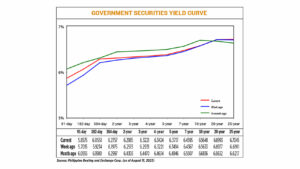




Monthly Economic Update: One for the road
 DOWNLOAD
DOWNLOAD

Inflation Update: Still low, still slow
 DOWNLOAD
DOWNLOAD

Philippines Trade Update: Exports momentum continues
 DOWNLOAD
DOWNLOAD


Gov’t debt yields climb on PH, US data

Yields n government securities (GS) traded in the secondary market rose last week, driven by US inflation data, Moody’s Investors Service’s downgrade of the credit ratings of some US banks, as well as the Philippine economy’s weaker-than-expected performance in the second quarter.
Bond yields, which move opposite to prices, went up by 4.76 basis points (bps) on average week on week, based on PHP Bloomberg Valuation Service Reference Rates as of Aug. 11 published on the Philippine Dealing System’s website.
Rates increased across all tenors last week. The 91-, 182- and 364-day Treasury bills (T-bills) climbed by 15.6 bps, 13.17 bps, and 7.82 bps to fetch 5.8575%, 6.0551%, and 6.2757%, respectively.
The belly of the curve also went up as yields on the two-, three-, four-, five-, and seven-year Treasury bonds (T-bonds) rose by 4.72 bps (6.2985%), 2.9 bps (6.3221%), 2.03 bps (6.3424%), 2.23 bps (6.3717%), and 2.28 bps (6.4595%), respectively.
Likewise, at the long end, the rates of the 10-, 20-, and 25-year debt papers inched up by 0.15 bp (6.5648%), 0.16 bp (6.6993%) and 1.34 bps (6.7045%), respectively.
Total GS volume traded amounted to PHP 4.65 billion on Friday, lower than the PHP 10.77 billion seen on Aug. 4.
“Local yields moved higher due to the lingering impact of the US sovereign credit downgrade and the possibility of a BSP (Bangko Sentral ng Pilipinas) rate hike from the recent depreciation of the peso,” a bond trader said in an e-mail.
The bond trader also attributed last week’s yield movements to data showing slower-than-expected Philippine gross domestic product (GDP) growth in the second quarter that dampened investor sentiment.
“On the international front, moderate US inflation reports have likewise dragged bond yields,” the bond trader added.
The market was mostly muted last week, even as investors reacted to key economic data releases, said Alessandra P. Araullo, chief investment officer at ATRAM Trust Corp.
“Overall, volume traded has been lackluster as the recent volatility of the peso, upcoming bond supply, and the overall uncertainty of monetary policy direction continue to be the key drivers to cause markets to remain on the sideline,” Ms. Araullo said.
The Philippine economy grew at its slowest pace in the second quarter, dampened by elevated inflation, lingering impact of rising borrowing costs, and a decline in government spending.
In the April-to-June period, GDP expanded to 4.3% year on year, decelerating from the 6.4% expansion in the first quarter, and the 7.5% print a year earlier, the Philippine Statistics Authority reported last week.
The latest figure was lower than the median estimate of 6% by 21 economists conducted in a BusinessWorld poll.
For the first semester, GDP growth averaged 5.3%, below the government’s 6-7% target.
Meanwhile, US consumer prices increased moderately in July amid lower costs for goods, including used motor vehicles, a trend that could persuade the US Federal Reserve to leave interest rates unchanged next month, Reuters reported.
The consumer price index (CPI) rose 0.2% last month, matching the gain in June, the Labor department said on Thursday. Though the increase in the annual CPI rate picked up for the first time in 13 months, that was because it was calculated from a lower base after prices subsided last July following a jump that had boosted inflation to a pace not seen in more than 40 years.
The CPI advanced 3.2% in the 12 months through July. That followed a 3.0% rise in June, which was the smallest year-on-year gain since March 2021.
Annual consumer prices have come down from a peak of 9.1% in June 2022. The Fed has a 2% inflation target.
On the other hand, Moody’s cut credit ratings of several small to mid-sized US banks on Monday and said it may downgrade some of the nation’s biggest lenders, warning that the sector’s credit strength will likely be tested by funding risks and weaker profitability.
For this week, Ms. Araullo said investors will look to gradually lock in rates at these higher levels while awaiting clarity on market direction in the near term.
“We expect (local) monetary policy to hinge on local inflation expectation path and overall direction of global and local growth,” she said.
For the bond trader, local yields are expected to move with an upward bias this week.
“[This], amid the fringe possibilities of a BSP rate hike due to the recent weakening of the peso and potential hawkish signals from the Federal Reserve policy minutes,” the bond trader said.
BSP Governor Eli M. Remolona, Jr. earlier warned against “sudden reversals” of monetary policy as inflation risks persist.
The Monetary Board’s next policy meeting will be held on Aug. 17. — Abigail Marie P. Yraola with Reuters
This article originally appeared on bworldonline.com





 By BusinessWorld
By BusinessWorld